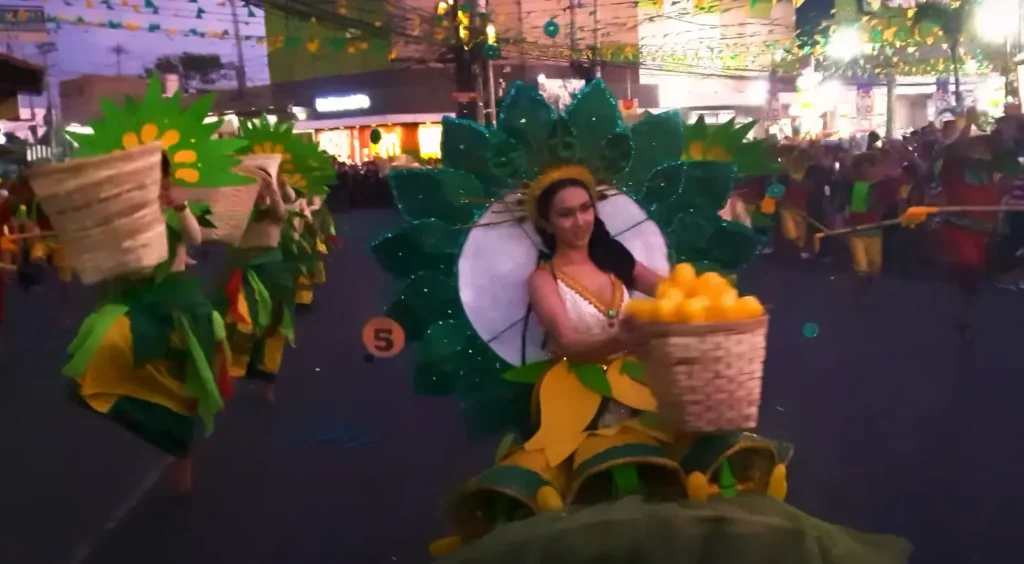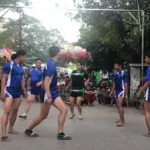Mingle with the masses at the Mango-Bamboo Festival and mark your calendar for a unique cultural treat. You’ll explore the sweet and sturdy specialties of San Carlos City, a place proud of its prolific mango orchards and bamboo crafts.
As you wander through vibrant displays and dynamic dances, you’re not just a spectator; you’re a participant in a tradition that supports local livelihoods. Whether you’re a fruit fanatic or a craft connoisseur, this festival offers a perfect blend of nature’s gifts and human ingenuity.
Key Takeaways
- The Mango-Bamboo Festival was launched in 2001 by then-Mayor Julian Resuello as an expansion of the Mango Festival, aiming to recognize the mango industry and the ubiquity of bamboo in San Carlos City.
- The festival plays a significant role in marketing mango and bamboo products, improving income for the people, and establishing connections for business endeavors in the town.
- San Carlos City is known as the center of trading for mango and bamboo products in the Pangasinan province, offering a wide range of products such as nipa huts, hand-woven items, furniture, cabinets, and lamp shades.
- The festival features various activities including a float parade, street dancing competition, beauty pageant, culinary contests, and showcases of mango pies and bamboo-craft competitions.
Facts About The Mango-Bamboo Festival Philippines
| Facts | Explanation |
|---|---|
| Name of the festival | Mango-Bamboo Festival Philippines |
| Type of festival | Cultural and agricultural festival |
| City of origin | San Carlos City, Philippines |
| Festival Etymology | The festival is named after two significant resources in the region – mangoes and bamboo. Mangoes are one of the primary agricultural products of the area, while bamboo represents the local craftsmanship and culture. |
| First celebration | April 5, 1987 |
| Founder of the Festival | Mayor Eugenio Ynion Jr. |
| Brief history of the festival | The Mango-Bamboo Festival was first celebrated on April 5, 1987, under the leadership of Mayor Eugenio Ynion Jr. The festival aimed to showcase the rich cultural heritage, agricultural abundance, and craftsmanship of San Carlos City. Over the years, it has grown into a significant event that attracts both local and foreign tourists. The festival features various activities such as street dancing, float parades, cultural shows, and exhibits highlighting the city’s mango industry and bamboo crafts. Through this festival, San Carlos City continues to promote its unique cultural identity and boost tourism in the region. |
| Brief history of the city | San Carlos City is a vibrant city located in the province of Negros Occidental in the Philippines. It was founded on November 4, 1898, and was originally a small settlement known for its fertile lands and abundant natural resources. Throughout history, the city has undergone significant development, particularly in agriculture and trade. Today, it is recognized as a progressive city with a strong mango industry and thriving bamboo crafts. The city’s rich history and cultural heritage make it an attractive destination for tourists seeking to explore the beauty and traditions of Negros Occidental. |
| Ethnic information | Majority: Negrenses (Hiligaynon-speaking) Minority: Visayan, Ilonggo, Cebuano, Filipino-Chinese, Indigenous groups: Ati, Bukidnon, Tumandok, Panay-Bukidnon |
| Location of the city | San Carlos City is situated in the northern part of Negros Occidental, one of the provinces in the Western Visayas region of the Philippines. It lies along the coast of Tañon Strait, facing the island of Cebu. The city is approximately 132 kilometers northeast of Bacolod City, the provincial capital. |
| How to reach the city | By air: The nearest airport is Bacolod-Silay International Airport, which serves domestic flights from Manila and Cebu. From the airport, you can take a bus or hire a private vehicle to reach San Carlos City. By land: San Carlos City is accessible by various bus companies from Bacolod City or other major cities in Negros Occidental. Buses also connect San Carlos City to neighboring provinces. By sea: There are ferry services available from Toledo City in Cebu to San Carlos City. |
| Nearby and surrounding cities or towns | 1. Bacolod City (132 km) 2. Escalante City (32 km) 3. Sagay City (49 km) 4. Victorias City (76 km) 5. Murcia (137 km) 6. Bago City (159 km) 7. Don Salvador Benedicto (83 km) 8. Cadiz City (84 km) 9. Manapla (68 km) 10. Toboso (65 km) 11. Calatrava (28 km) |
| Google map link | San Carlos City on Google Maps |
| Festival main events and activities | – Street dancing competition showcasing local cultural dances and costumes – Float parades featuring creatively designed floats adorned with mangoes and bamboo crafts – Trade fairs highlighting local products and delicacies – Exhibits showcasing mango farming techniques and bamboo craftsmanship – Cultural shows featuring traditional music and dance performances – Beauty pageants crowning the Mango-Bamboo Festival Queen and other titles – Sports competitions promoting physical fitness and camaraderie among participants |
| Other famous tourist attractions in the city | – Sipaway Island – A nearby island known for its white sand beaches and diving spots – Gawahon Eco Park – A nature park offering trekking trails and scenic views of waterfalls – San Carlos Borromeo Cathedral – A beautiful church with intricate architecture and religious significance – Ruins of Hacienda Tolosa – Remnants of an old sugar mill with historical importance – Bais Bay – A coastal area known for dolphin watching and marine biodiversity |
| Famous food dishes of the city | – Mango Pizza – A unique pizza topped with fresh mangoes for a sweet and savory flavor combination – Inasal – Grilled chicken marinated in local spices and served with rice and dipping sauce – KBL (Kadios, Baboy, Lambong) – A traditional soup made with pigeon peas, pork, and bamboo shoots – Piaya – A sweet flatbread filled with muscovado sugar or other sweet fillings – Mango Float – A popular dessert made with layers of graham crackers, cream, and ripe mangoes |
| Landmarks in the city | – Mangrove Eco-Park – A protected mangrove forest offering nature trails and boat tours – Bantug Lake Ranch – A scenic ranch with horseback riding facilities – Malogo River – A river known for its crystal-clear waters and picturesque surroundings – Igbaclag Cave – A cave system with impressive rock formations and underground rivers – Kara-an Underground River – An underground river system ideal for spelunking adventures |
| Related festivals in the same region | Sinulog Festival (Cebu City) Pintados-Kasadyaan Festival (Tacloban City) Ati-Atihan Festival (Kalibo, Aklan) Masskara Festival (Bacolod City) Kadayawan Festival (Davao City) |
Festival Origins and Significance
The “Mango-Bamboo Festival” is celebrated in San Carlos City, Philippines to honor and showcase the thriving mango and bamboo industries in the region. The festival originated in 1987 under the leadership of Mayor Eugenio Ynion Jr., to promote the city’s rich cultural heritage, abundant agricultural resources, and skilled craftsmanship.
San Carlos City is known as the center of trading for mango and bamboo products in the Pangasinan province. The festival serves as a platform to market and highlight these products, boosting income for local farmers and artisans while establishing connections for business ventures in the town.
The name “Mango-Bamboo Festival” itself represents the two significant resources in the region – mangoes and bamboo. Mangoes are a primary agricultural product of San Carlos City, while bamboo represents the local craftsmanship and cultural heritage.
Over the years, the festival has grown into a significant event attracting both local and foreign tourists. It features various activities such as street dancing competitions, float parades, cultural shows, exhibits, culinary contests, and beauty pageants. These events offer a unique blend of nature’s gifts and human ingenuity, showcasing the versatility of mangoes and bamboo in various forms.
Highlighted Festival Events
Annually, you witness the vibrant transformation of San Carlos City as it hosts the Mango-Bamboo Festival, with a variety of events that celebrate its agricultural pride and craftsmanship.
You’re bound to be mesmerized by the creative mango bamboo artwork displayed throughout the city. Artisans conjure up intricate designs, blending the sweetness of mangoes with the strength of bamboo in their pieces, from sculptures to functional items.
As you meander through the festival, the cultural performances captivate your senses. Each dance and musical act tells a story of the city’s rich heritage, creating a tapestry of tradition and modernity. Whether you’re a local or a traveler, these highlighted events offer a glimpse into the heart of San Carlos City, leaving you with a deeper appreciation for its unique cultural landscape.
Celebrating Mango and Bamboo
As you explore the Mango-Bamboo Festival, you’ll discover the seamless integration of San Carlos City’s prized mangoes and versatile bamboo in every aspect of the celebration.
This festivity isn’t just a display of cultural heritage; it’s a testament to the mango and bamboo industry growth that’s been shaping the local economy. You’re witnessing how these industries enrich the lives of the townspeople, not just culturally but economically as well.
The festival’s cultural and economic impact can’t be overstated. It’s a vibrant platform for local artisans and farmers to showcase their products, from luscious mangoes to intricate bamboo crafts.
Getting to San Carlos City
To reach San Carlos City for the Mango-Bamboo Festival, you can catch a bus from Clark International Airport, which is about a two-hour drive away.
This convenient public transportation option lets you soak in the scenic views without the stress of navigating unfamiliar roads. Along the way, you might spot some nearby attractions worth a visit, like local markets or historical landmarks that dot the landscape.
Once in San Carlos City, the festival’s vibrant sights and sounds will welcome you. Dive into the cultural tapestry, where the sweet scent of mangoes and the intricate designs of bamboo crafts await. Remember, planning your trip around bus schedules ensures a smooth journey, leaving you with more time to enjoy the festivities.
Visitor Information Resources
You’ll find numerous resources to help plan your visit to the Mango-Bamboo Festival in San Carlos City. The city’s information office is a treasure trove of tips on visitor attractions and local accommodations. Whether you’re looking for the perfect spot to witness the vibrant float parade or need guidance on where to taste the finest mango pies, they’ve got you covered.
Reach out via email at [email protected] or check their Facebook page for updates and recommendations. Don’t miss the chance to explore the unique handcrafted bamboo items and immerse yourself in the local culture.
Remember, comfortable stays are crucial after a day of festivities, so inquire about the best places to rest your head and recharge for another day of adventure.


